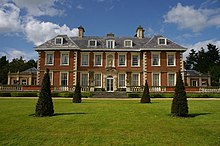Highnam Court
| Highnam Court | |
|---|---|

South facade of Highnam Court
|
|
|
Location of Highnam Court in Gloucestershire
|
|
| General information | |
| Type | Country house |
| Architectural style | Artisan Mannerism |
| Location | Highnam, Gloucestershire, England |
| Coordinates | 51°52′20″N 2°18′05″W / 51.872119°N 2.301292°WCoordinates: 51°52′20″N 2°18′05″W / 51.872119°N 2.301292°W |
| Construction started | 1658 |
| Renovated | 1994 - present (most recent) |
| Owner | Roger Head |
| Height | |
| Roof | Hipped, Slate |
| Designations | Grade I Listed |
Highnam Court is a grade I listed country house in Highnam, Gloucestershire, England constructed in the 17th century. The estate passed from the Cooke family to the Guise family and, in the mid 19th century, was purchased by a member of the Gambier-Parry family. Renovations were undertaken during the tenures of the Guise and Gambier-Parry families, with the latter also including extensive development of the grounds. The Gambier-Parry family held the estate until the late 20th century.
Highnam Court (pictured) is a 17th-century, grade I listed building in Highnam, Gloucestershire, just north of the A40. The country house was built in 1658 for William Cooke, the son of Sir Robert Cooke, following damage to the original structure in the English Civil War.
Following William Cooke's death in 1703, the estate was inherited by his son Edward Cooke. The latter was succeeded upon his death about 1724 by his son Dennis Cooke. After Dennis Cooke's demise in 1747, Highnam Court was inherited by his sisters. The manor underwent improvements of its interior in the 18th century for owner Sir John Guise, 1st Baronet, the son of one of Dennis Cooke's sisters. Further alterations were made in the early 19th century for his son and successor, Sir Berkeley William Guise, 2nd Baronet. Following his death in 1834, his brother, Sir John Wright Guise, was heir to the estate.
Thomas Gambier-Parry purchased the estate from Guise in 1838. Architect Lewis Vulliamy renovated the house for him in 1840 and 1855. Changes included the construction of a single-story wing across the rear of the manor, as well as the extension of a service wing which dated to the early 19th century. Further renovations by David Brandon in 1869 were also performed on behalf of Gambier-Parry, and included a billiard room. Thomas Gambier-Parry died in 1888; his widowed second wife Ethelinda Lear retained the manor until her demise in 1896. She was succeeded by her husband's son, the youngest child of his first marriage, composer Sir Charles Hubert Hastings Parry. Upon Parry's death in 1918, his half-brother Major Ernest Gambier-Parry succeeded to the estate. After the major's death in 1936, the estate passed to his one surviving son, Thomas Mark Gambier-Parry, who resided at Highnam Court until his death in 1966. About 1950, before his demise, he made a gift of the farms of the estate to W. P. Cripps, his cousin. Thomas Mark Gambier-Parry was succeeded by his cousin, Thomas Gambier-Parry's great-grandson, Thomas Fenton, who inherited Highnam Court as a teenager. Before his death in 2010, Fenton gave documents related to the administration of the estate, covering the period from 1650 to 1940, to the Gloucestershire Archives.
...
Wikipedia

